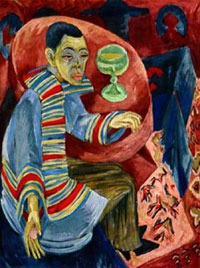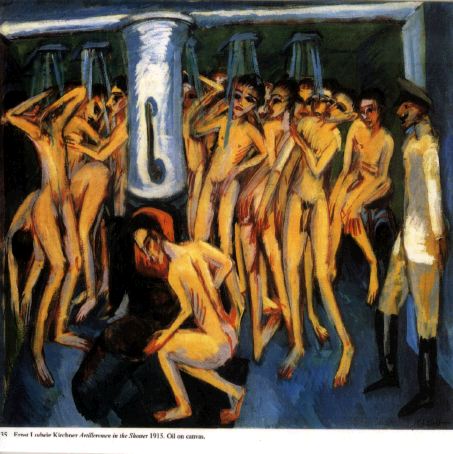Ernst Ludwig Kirchner (1880 – 1938)
Get a Kirchner Certificate of Authenticity for your painting or a COA for your Boucher drawing or print.
For all your Kirchner artworks you need a Certificate of Authenticity in order to sell, to insure or to donate for a tax deduction.
How to get a Kirchner Certificate of Authenticity is easy. Just send us photos and dimensions and tell us what you know about the origin or history of your Kirchner painting, drawing or print.
If you want to sell your Kirchner painting, drawing or print use our selling services. We offer Kirchner selling help, selling advice, private treaty sales and full brokerage.
We have been authenticating Kirchner and issuing certificates of authenticity since 2002. We are recognized Kirchner experts and Kirchner certified appraisers. We issue COAs and appraisals for all Kirchner artworks.
Our Kirchner paintings, drawings and print authentications are accepted and respected worlwide.
Each COA is backed by in-depth research and analysis authentication reports.
The Kirchner certificates of authenticity we issue are based on solid, reliable and fully referenced art investigations, authentication research, analytical work and forensic studies.
We are available to examine your Kirchner painting, drawing or print anywhere in the world.
You will generally receive your certificates of authenticity and authentication report within two weeks. Some complicated cases with difficult to research Kirchner paintings or drawings take longer.
Our clients include Kirchner collectors, investors, tax authorities, insurance adjusters, appraisers, valuers, auctioneers, Federal agencies and many law firms.
We perform Ernst Kirchner art authentication, appraisal, certificates of authenticity (COA), analysis, research, scientific tests, full art authentications. We will help you sell your Ernst Kirchner or we will sell it for you.

Ernst Kirchner was a German expressionist painter and printmaker and one of the founders of the artists group Die Brücke or “The Bridge.” Born in Aschaffenburg, Germany, Kirchner studied architecture in Dresden beginning in 1901. While in Dresden, he befriended three other young architecture students, Erich Heckel, Karl Schmidt-Rottluff, and Fritz Bleyl. This young group was drawn together by their desire to become painters as well as by their dislike of modern painting. They began calling themselves Die Brücke, which described their liking of “all revolutionary and surging elements”. The group sought inspiration in such painters as Vincent Van Gogh, Paul Gauguin, and Edvard Munch as well as the primitive arts of Africa and the Pacific Islands.

Kirchner’s own artistic development began with woodcuts he created in the years before 1900. After studying architecture, he studied painting in Munich and was influenced there by Art Nouveau styles as well as by the woodcuts of Albrecht Dürer. In Munich, Kirchner’s style of painting developed as he began using bold colors, reminiscent of Gauguin, and wild brushstrokes reminiscent of Van Gogh. His portrayal of subjects conveys an emotional intensity similar to that found in the woodcuts of Dürer and Munch.

With the onset of World War I, Kirchner entered military service, and in 1915, he suffered a nervous breakdown and physical collapse. In a self-portrait of this time he depicts himself with an amputated hand (this did not actually happen). He moved to a sanitarium near Frankfurt, where he completed five wall frescoes in 1916, but was struck by a car and severely injured. In 1918 he moved near Davos, Switzerland to convalesce, but continued to suffer from depression despite solo shows held in Munich, Hamburg, and New York.

Kirchner wrote critical appraisals of his own work under his nom de critique, “L. de Marsale.”[1] He repainted earlier works, and also changed the dates on some in order to predate Fauvism, which he claimed not to be influenced by. His position in the artistic vanguard had also been threatened by the emergence of Cubism and for a time he worked in a manner derived from it. The works for which he is most noted are those prior to his war service, in particular a series of graphics and paintings depicting street life (i.e. prostitutes) in Berlin.
His printmaking was very extensive, including 971 woodcuts, 665 etchings and 458 lithographs in the Dube Catalogue raisonné. His inclusion in Entartete Kunst, the Nazis’ 1937 exhibition of so-called “degenerate art,” along with the destruction of approximately 600 of his works, caused him further distress, exacerbated by the closeness of his Swiss home to the German border. Kirchner committed suicide in 1938 in Davos.
Still wondering about a German painting in your family collection? Contact us…it could be by Ernst Kirchner.
Reviews
1,217 global ratings
5 Star
4 Star
3 Star
2 Star
1 Star
Your evaluation is very important to us. Thank you.
